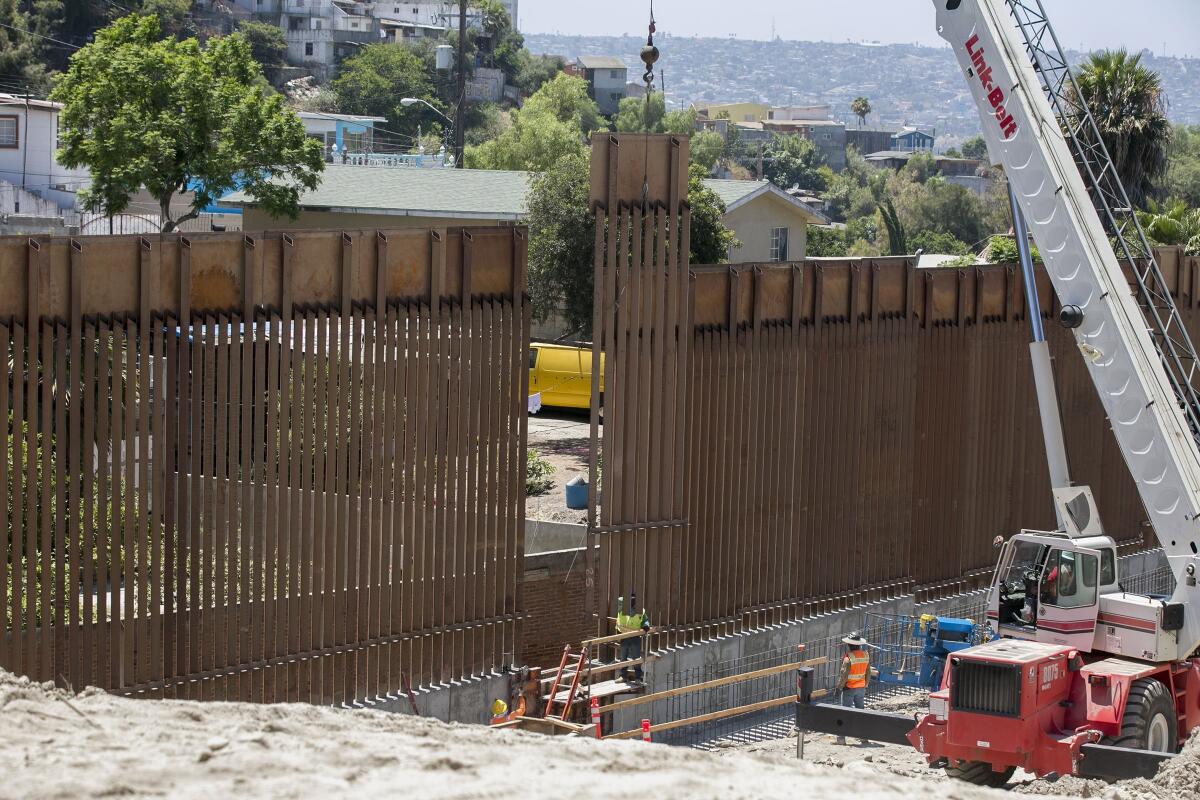New fence replaces decades-old border wall in San Diego

San Diego — Along a dirt road situated between a middle-class neighborhood in eastern Tijuana and warehouses in Otay Mesa, border patrol agents celebrated the completion of a $147-million border wall replacement project Friday.
San Diego Sector Acting Deputy Chief Patrol Agent Kathleen Scudder stood in front of a row of television cameras while a crane filled the lone remaining gap of a 14-mile stretch of border fencing between the Pacific Ocean and Otay Mountain with an 18-foot tall steel barrier.
Those steel beams replaced much shorter Vietnam-era metal panels that were originally installed in the mid-1990s to stop people from driving across the border.
The steel panels accomplished that goal, but illegal border crossings have evolved, modernized and adapted. Smugglers could easily climb the steel panels — which were as short as four feet in some places — and push them over in certain places.
Coupled with other border infrastructure in the area — including stadium lighting, motion sensors, cameras and, of course, Border Patrol agents — the new border fence should increase agent safety and decrease human and drug smuggling, Scudder said.
“One part of that system doesn’t work alone,” she said. “A wall of a fence isn’t going to keep people out, necessarily. We don’t build the walls to be a complete deterrent. They are one tool as part of the system.”
Those individual parts of the system performing together give Border Patrol agents the ability to work smarter with finite resources to secure the southern border, she added. Border Patrol agents said the taller steel beams are an upgrade from the Vietnam-era steel panels in two major ways.
First, they can see through spaces in between the steel beams so the agents won’t be caught off guard by people running up to the fence or even throwing rocks over the structure. Second, the taller obstacle takes longer to climb, which gives agents more time to respond.
“If we didn’t have a wall like this and you could just jump over within seconds,” said agent Vincent Pirro. “How fast can you be in a car? You’ll be in a car into the United States in a matter of minutes.”
Friday marked the completion of San Diego’s border replacement project, which began in May 2018.
This wasn’t part of the new border wall that President Trump first promised to build — and have Mexico pay for — in 2016.
The Trump administration had a difficult time securing the billions needed for that border project. Originally, Congress only appropriated $1.3 billion. Because that was not enough, the president declared a state of emergency along the southwestern border to secure military funding for the wall.
That decision was originally challenged in court, but a Supreme Court ruling last month allowed the Trump administration to use military funding to pay for the wall.
This project was part of a plan proposed in 2009 by the Obama administration and funded in 2017 by the Trump administration to replace existing border barriers.
Here in San Diego, there are more plans to replace the secondary border fence — a steel-mesh fence about 20-feet north of the primary fence — with 30-foot tall steel beams similar to the ones in the primary fence. That secondary fence project is currently underway and should be completed by January 2020.
Other than those replacement projects, there are no plans to install new fencing in San Diego, which is already one of the most heavily fortified sections of the entire southwestern border.
Scudder noted that in San Diego there has been a strong correlation between more border infrastructure and less human and drug smuggling.
“This replacement barrier will only increase that effect, benefiting the local economy, area security and the environment,” she said.
Statistics show that both forms of smuggling have decreased significantly in San Diego since 2001.
That year, there were 110,000 apprehensions along the border and agents seized more than 26,000 pounds of marijuana. In fiscal year 2019, apprehensions were at 51,800 and agents only found 2,000 pounds of marijuana.
The amount of meth and heroin, however, has increased significantly during that same time period. Agents seized 18 pounds of meth in 2001 and almost 3,000 pounds in 2019. With heroin, agents seized 116 pounds in 2001 and 3,500 in 2019.
More to Read
Sign up for Essential California
The most important California stories and recommendations in your inbox every morning.
You may occasionally receive promotional content from the Los Angeles Times.










